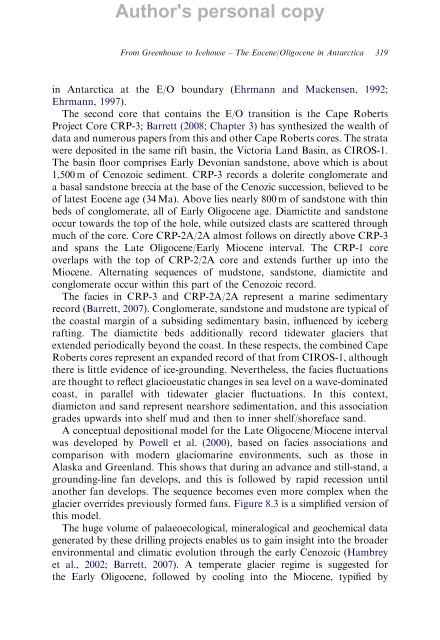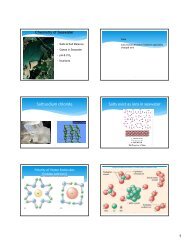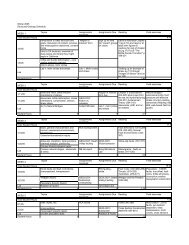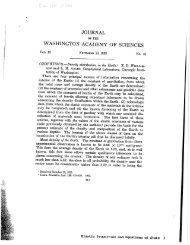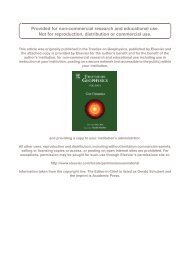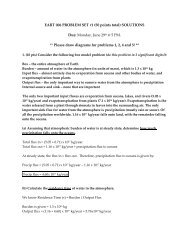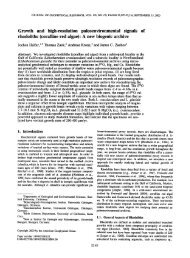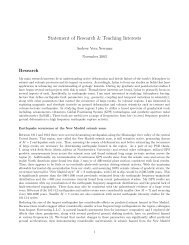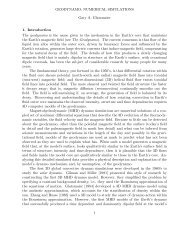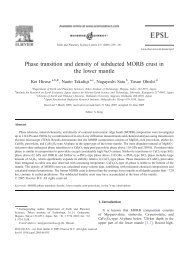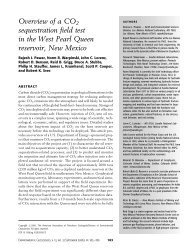From Greenhouse to Icehouse – The Eocene/Oligocene - UMass ...
From Greenhouse to Icehouse – The Eocene/Oligocene - UMass ...
From Greenhouse to Icehouse – The Eocene/Oligocene - UMass ...
You also want an ePaper? Increase the reach of your titles
YUMPU automatically turns print PDFs into web optimized ePapers that Google loves.
Author's personal copy<br />
<strong>From</strong> <strong>Greenhouse</strong> <strong>to</strong> <strong>Icehouse</strong> <strong>–</strong> <strong>The</strong> <strong>Eocene</strong>/<strong>Oligocene</strong> in Antarctica 319<br />
in Antarctica at the E/O boundary (Ehrmann and Mackensen, 1992;<br />
Ehrmann, 1997).<br />
<strong>The</strong> second core that contains the E/O transition is the Cape Roberts<br />
Project Core CRP-3; Barrett (2008; Chapter 3) has synthesized the wealth of<br />
data and numerous papers from this and other Cape Roberts cores. <strong>The</strong> strata<br />
were deposited in the same rift basin, the Vic<strong>to</strong>ria Land Basin, as CIROS-1.<br />
<strong>The</strong> basin floor comprises Early Devonian sands<strong>to</strong>ne, above which is about<br />
1,500 m of Cenozoic sediment. CRP-3 records a dolerite conglomerate and<br />
a basal sands<strong>to</strong>ne breccia at the base of the Cenozic succession, believed <strong>to</strong> be<br />
of latest <strong>Eocene</strong> age (34 Ma). Above lies nearly 800 m of sands<strong>to</strong>ne with thin<br />
beds of conglomerate, all of Early <strong>Oligocene</strong> age. Diamictite and sands<strong>to</strong>ne<br />
occur <strong>to</strong>wards the <strong>to</strong>p of the hole, while outsized clasts are scattered through<br />
much of the core. Core CRP-2A/2A almost follows on directly above CRP-3<br />
and spans the Late <strong>Oligocene</strong>/Early Miocene interval. <strong>The</strong> CRP-1 core<br />
overlaps with the <strong>to</strong>p of CRP-2/2A core and extends further up in<strong>to</strong> the<br />
Miocene. Alternating sequences of muds<strong>to</strong>ne, sands<strong>to</strong>ne, diamictite and<br />
conglomerate occur within this part of the Cenozoic record.<br />
<strong>The</strong> facies in CRP-3 and CRP-2A/2A represent a marine sedimentary<br />
record (Barrett, 2007). Conglomerate, sands<strong>to</strong>ne and muds<strong>to</strong>ne are typical of<br />
the coastal margin of a subsiding sedimentary basin, influenced by iceberg<br />
rafting. <strong>The</strong> diamictite beds additionally record tidewater glaciers that<br />
extended periodically beyond the coast. In these respects, the combined Cape<br />
Roberts cores represent an expanded record of that from CIROS-1, although<br />
there is little evidence of ice-grounding. Nevertheless, the facies fluctuations<br />
are thought <strong>to</strong> reflect glacioeustatic changes in sea level on a wave-dominated<br />
coast, in parallel with tidewater glacier fluctuations. In this context,<br />
diamic<strong>to</strong>n and sand represent nearshore sedimentation, and this association<br />
grades upwards in<strong>to</strong> shelf mud and then <strong>to</strong> inner shelf/shoreface sand.<br />
A conceptual depositional model for the Late <strong>Oligocene</strong>/Miocene interval<br />
was developed by Powell et al. (2000), based on facies associations and<br />
comparison with modern glaciomarine environments, such as those in<br />
Alaska and Greenland. This shows that during an advance and still-stand, a<br />
grounding-line fan develops, and this is followed by rapid recession until<br />
another fan develops. <strong>The</strong> sequence becomes even more complex when the<br />
glacier overrides previously formed fans. Figure 8.3 is a simplified version of<br />
this model.<br />
<strong>The</strong> huge volume of palaeoecological, mineralogical and geochemical data<br />
generated by these drilling projects enables us <strong>to</strong> gain insight in<strong>to</strong> the broader<br />
environmental and climatic evolution through the early Cenozoic (Hambrey<br />
et al., 2002; Barrett, 2007). A temperate glacier regime is suggested for<br />
the Early <strong>Oligocene</strong>, followed by cooling in<strong>to</strong> the Miocene, typified by


